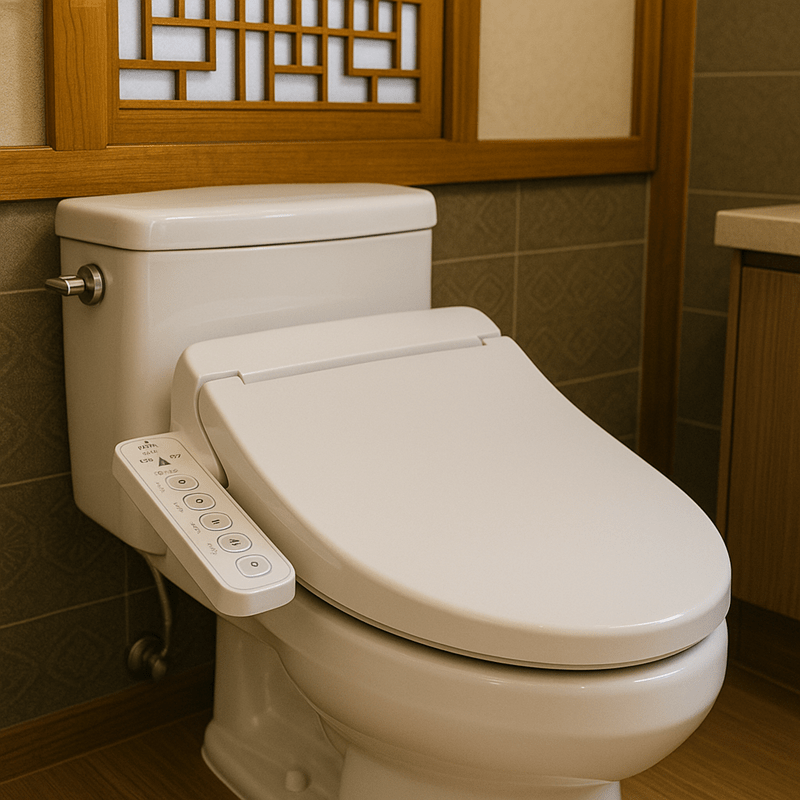
The One Big Difference Between a Bidet and a Washlet
Today, it’s not surprising to find a bidet in most South Korean homes, hotels, or even public restrooms. But just a few decades ago, the bidet was a rare and expensive import from Japan—virtually unknown to the average Korean household. So how did Korea go from no bidets to developing some of the world’s smartest and most user-friendly models?
Here’s how the Korean bidet revolution began—and why it’s now setting global standards for bathroom hygiene.
Bidet Enters Korea
South Korea first encountered electronic bidets in the mid-1980s, when Japanese-made devices—especially TOTO’s Washlet—were imported in small numbers. These early units were used only in upscale locations, such as luxury homes, high-end spas, and international hospitals. At the time, the bidet was seen as a high-end, foreign hygiene gadget, not something for everyday homes.
Back then, most Koreans had never seen or heard of a bidet, and its high price and complex installation made it unrealistic for typical households.
The One Big Difference Between a Bidet and a Washlet 👆The Rise of Local Brands
The real turning point came in the late 1990s, when Korean companies began producing their own electronic bidets. Leading the way were brands like Woongjin Coway, LG Electronics, ChungHo Nais, and Daelim Bath. These companies understood the local market and started designing bidets that were:
-
More affordable
-
Easy to install in Korean bathrooms
-
Equipped with Korean-language control panels
-
Supported by rental and maintenance services
This shift made the bidet accessible to middle-class families, and public awareness of the product began to grow.
How the Electronic Bidet Evolved 👆Bidets Go Mainstream
In the early 2000s, bidets became a household staple in Korea—thanks to aggressive marketing, improved designs, and the growing popularity of rental services.
Brands like Coway offered monthly rental plans that included regular maintenance, making bidets easy to try without a large upfront cost.
As consumer interest grew, companies added new features such as:
-
Heated seats
-
Adjustable water pressure and temperature
-
Nozzle self-cleaning
-
Warm air drying
By this point, bidets were not only found in homes, but also in restaurants, department stores, and office buildings.
The Origins of the Bidet: A Forgotten French Invention 👆The Smart Toilet Era
Fast forward to today, and Korea’s bidets have evolved into high-tech smart hygiene appliances. Modern features include:
-
Instant heating with direct water supply (no water tank)
-
Automatic lid opening and closing
-
Deodorizing systems and air purifiers
-
UV nozzle sterilization
-
Child-safe and female care modes
Some models even connect to apps or smart home systems, allowing you to customize settings and monitor hygiene usage remotely.
What Makes Korean Bidets Unique?
Korea didn’t just adopt the bidet—it reimagined it for modern living.
Here’s what makes Korean-style bidets stand out:
-
Designed for compact bathrooms with space-saving models
-
Fast heating and strong water pressure ideal for seasonal climates
-
User-friendly rental and warranty systems
-
Targeted hygiene features for women, children, and seniors
-
Affordable pricing across a wide range of models
These innovations have helped Korean bidets gain popularity abroad—in the United States, Southeast Asia, and even the Middle East—as more people look for clean, eco-friendly alternatives to toilet paper.
From Import to Innovation
What started as a rare, imported product has now become a Korean household essential.
Today, Korea’s bidet market is a blend of cutting-edge tech, user-first design, and cultural innovation—and it’s setting the tone for the future of bathroom hygiene worldwide.
[…] Korea’s Bidet Boom […]